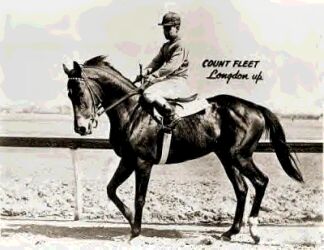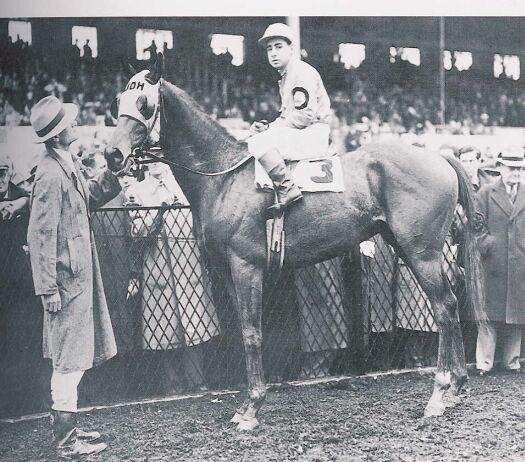

During the summer of 1927, a chestnut colt owned by Willis Sharpe Kilmer caught the eye of John D. Hertz, who later founded the rental car company that bears his name, when he reached out and bit another horse during a race. Hertz was said to "love a fighter, man or horse," and he promptly bought the spirited juvenile. The colt was Reigh Count, and wearing the colors of Mrs. John Hertz, he won the next year's Kentucky Derby, among other races, and earned Horse of the Year honors. When he was retired to stud, he at first failed to sire a major winner, and John D. Hertz limited the number of mares he covered each year to four, although he felt that if Reigh Count were bred to a mare with some talent for sprinting, the result might be a top performer.
In 1937 Hertz paid Joseph D. Widener $2,500 for a mare named Quickly, who had won thirty-two of eighty-five races, with all of her victories coming in sprints. More importantly, she was inbred to the famous English stallion The Tetrarch, whom Hertz admired. On March 24, 1940 she produced a brown colt by Reigh Count who proved to be so difficult to handle that he was put up for sale, but his manners discouraged any would-be buyers. Only one person believed in the horse, and that was stable employee Sam Ramsen, who pleaded with the manager of Stoner Creek Stud on Count Fleet's behalf, saying:
"Someday he's going to be one fine racer. When that leggy brown colt wants to run, he can just about fly."
He hoped the manager would try to convince Mr. Hertz not to sell the colt. It was a lack of buyers, however, that caused him to keep Count Fleet as a yearling. The colt was sent to trainer Don Cameron, and he raced in the name of Mrs. Hertz. The first time out, at Belmont Park, Count Fleet bumped a colt named Vacuum Cleaner and finished a beaten second. He repeated the performance in his next start as well, this time missing in a maiden event at Aqueduct. The war caused Hertz to consider cuts in his stable, and shortly after his second loss, Count Fleet was again offered for sale.
Johnny Longden, the colt's jockey, happened upon another trainer contemplating the purchase of Count Fleet. Bicycling to a nearby phone booth, the rider called John Hertz, expressing his high opinion of the colt.
"The colt's dangerous. Someday I'm afraid he'll do you serious injury," said Hertz.
"I'm not afraid," the jockey returned. Mr. Hertz agreed to keep the colt, seeing that Longden was willing to face the "danger" involved in riding him.
Therefore, Count Fleet was still wearing the colors of Mrs. Hertz when he broke his maiden, winning his third start by four lengths. His time was 1:06 for the five and a half furlongs, and he was a fifth of a second quicker in winning the next time out. After the second success, he was entered in the East View Stakes, but was upset by Gold Shower, adding another place finish to his record. Count Fleet successfully sought revenge by taking the Wakefield Stakes, with his former conqueror a distant third, and headed west for the Washington Park Futurity, where he met the Arlington Futurity and Washington Park Juvenile Stakes winner Occupation. With Count Fleet stuck in traffic, Occupation caught the early leaders and was on top by three lengths in the stretch when the fleet-footed Count made a late run, drawing within a neck of the leader before running out of ground.
Count Fleet also met defeat in the Tremont Stakes, this time in the form of William du Pont's bay colt Supermont, whose sire, Rosemont, had upset such stars as War Admiral, Discovery, and Seabiscuit.
Seeking vengeance for the narrow defeat at Washington Park, Count Fleet met Occupation again after a pair of victories in allowance races and a record breaking work of 1:08 1/5. The impressive morning breeze did as much for the Count's reputation as had his afternoon performances, and that Count Fleet would defeat his rival seemed a sure thing. But revenge was elusive, and Occupation went wire to wire, beating him once more as Count Fleet followed the champion filly Askmenow around the racetrack and ended up third.
Now with a serious score to settle, Count Fleet followed a six length victory in the Champagne Stakes, in which he ran the year's fastest mile of 1:34 4/5, a new track record, by taking one last shot at Occupation in the Pimlico Futurity. Breaking on top and leading for five furlongs, the favored Occupation seemed at first to have a third defeat in store for his rival, but Count Fleet avenged his previous losses with a five length win, equaling the track record of 1:43 3/5 in the process. Count Fleet had found his stride, because in his final outing of the year, the leggy brown colt turned the Walden Stakes into something barely resembling a race, winning by at least thirty lengths and wrapping up the championship honors that had seemed to belong to Occupation only a month before. His weight assignment of 132 pounds on the Experimental Free Handicap is a record that still stands.
Count Fleet made his three-year-old debut at the
distance of a mile and seventy yards, winning the St.
James Purse without much effort. He then made Blue Swords
and Slide Rule, both excellent horses, look like cheap
claimers while going a mile and a sixteenth in 1:43 in the
Wood Memorial. In winning the Wood, Count Fleet struck his own left hind leg, and the injury was serious enough
to threaten his participation in the Kentucky Derby. He
was shipped to Churchill Downs by rail, and jockey Johnny
Longden rode with him, holding ice on the horse's damaged
left rear.
his own left hind leg, and the injury was serious enough
to threaten his participation in the Kentucky Derby. He
was shipped to Churchill Downs by rail, and jockey Johnny
Longden rode with him, holding ice on the horse's damaged
left rear.
In the spring of 1943, the United States was in the midst of the second world war. Severe limitations had been placed upon travel, and the restrictions threatened the Kentucky Derby itself until Matt Winn promised that only those from the Louisville area would be present. Taxis were forbidden to be within a mile of the track, and private vehicles were restricted as well. The restrictions placed on the public by the head of Churchill Downs prompted the 1943 Run for the Roses to be dubbed the Street-Car Derby.
The Kentucky Derby turned out to be an easy win for Count Fleet, who outclassed the field to win impressively while Blue Swords ran second for what was neither the first nor the last time, with Slide Rule third.
The story was the same at Pimlico, where Count Fleet scored an effortless victory while Blue Swords ran second once again, eight lengths behind. Noted The Blood-Horse:
"If Count Fleet is the spectacular comet in the racing skies of 1943, then Blue Swords is the comet's tail."
Entered in the Withers Stakes, Count Fleet won with ease, cantering home six lengths ahead of Slide Rule, who had skipped the Preakness after a third place finish at Churchill Downs. After watching their entries struggle home behind a loafing Count Fleet in the Kentucky Derby, Preakness Stakes, and Withers Stakes, the owners of Blue Swords and Slide Rule finally gave their horses a break and spared them the humiliation of the Belmont, leaving Count Fleet to beat a pair of allowance class horses by twenty-five lengths, becoming the sixth Triple Crown winner. Later, Johnny Longden expressed the confidence he had in Count Fleet before the Belmont Stakes:
"Going into the race, I thought he'd have to fall down to get beat, and even then I thought he could get up and win. He was that good."
Count Fleet was retired early when it was discovered that his injured near front fetlock, wrenched in the Belmont Stakes, would not respond to treatment. Johnny Longden explained what it took to ride the great horse:
"Get him out on top, give him the race track, and let him run. It was what he loved to do more than anything else."
Yet even though the jockey compared riding his greatest mount to driving a Cadillac, he admitted it wasn't always that easy, saying:
"...if he didn't have racing room, he'd go to the outside or just climb over horses. If you were in close quarters with him, you were in trouble."
The retirement of Count Fleet came as a relief to not only Blue Swords, whom he had beaten six times, but to those employed by Don Cameron as hot walkers. Even after the mile and a half of the Belmont Stakes, the leggy brown colt came back to the barn full of energy, and routinely wore out two hot walkers before his forty five minutes of walking were complete.

Count Fleet enjoyed great success at stud. His get included One Count, who shared Horse of the Year honors with the two-year-old star Native Dancer in 1952 and won the Belmont Stakes, the Travers Stakes, and the Jockey Club Gold Cup; Counterpoint, winner of the 1951 Belmont Stakes and the Jockey Club Gold Cup while on his way to honors as Horse of the Year; Kiss Me Kate, who was named Champion Three Year Old Filly; and 1951 Kentucky Derby winner Count Turf, who was named in honor of his owner's Turf Restaurant in New York City. The Fleet's daughters produced Kelso, Lamb Chop, Quill, Prince John, and Lucky Debonair. Count Fleet is buried at Stoner Creek, where he died in on December 3, 1973.
| Year | Starts | Wins | Seconds | Thirds | Earnings |
|---|---|---|---|---|---|
| Lifetime | 21 | 16 | 4 | 1 | $250,300 |
| Reigh Count | Sunreigh | Sundridge | Amphion |
| Sierra | |||
| Sweet Briar II | St. Frusquin | ||
| Presentation | |||
| Contessina | Count Schomberg | Aughrim | |
| Clonavarn | |||
| Pitti | St. Frusquin | ||
| Florence | |||
| Quickly | Haste | Maintenant | Maintenon |
| Martha Gorman | |||
| Miss Malaprop | Meddler | ||
| Correction | |||
| Stephanie | Stefan the Great | The Tetrarch | |
| Perfect Peach | |||
| Malachite | Rock Sand | ||
| Miss Hanover |

Video by Carly Kaiser



This text protected by all applicable copyright laws. Do not duplicate or distribute without written permission. © Spiletta42.